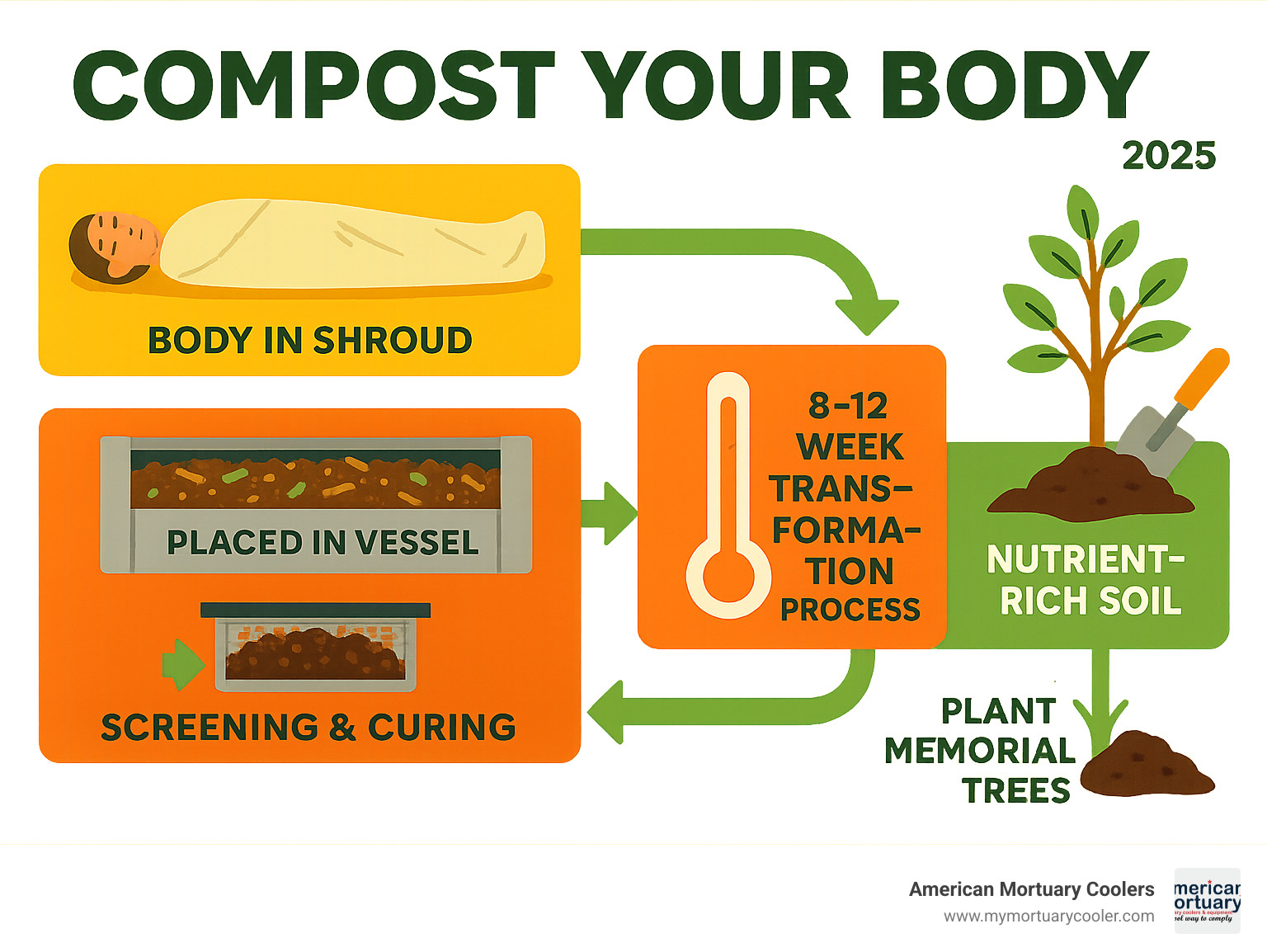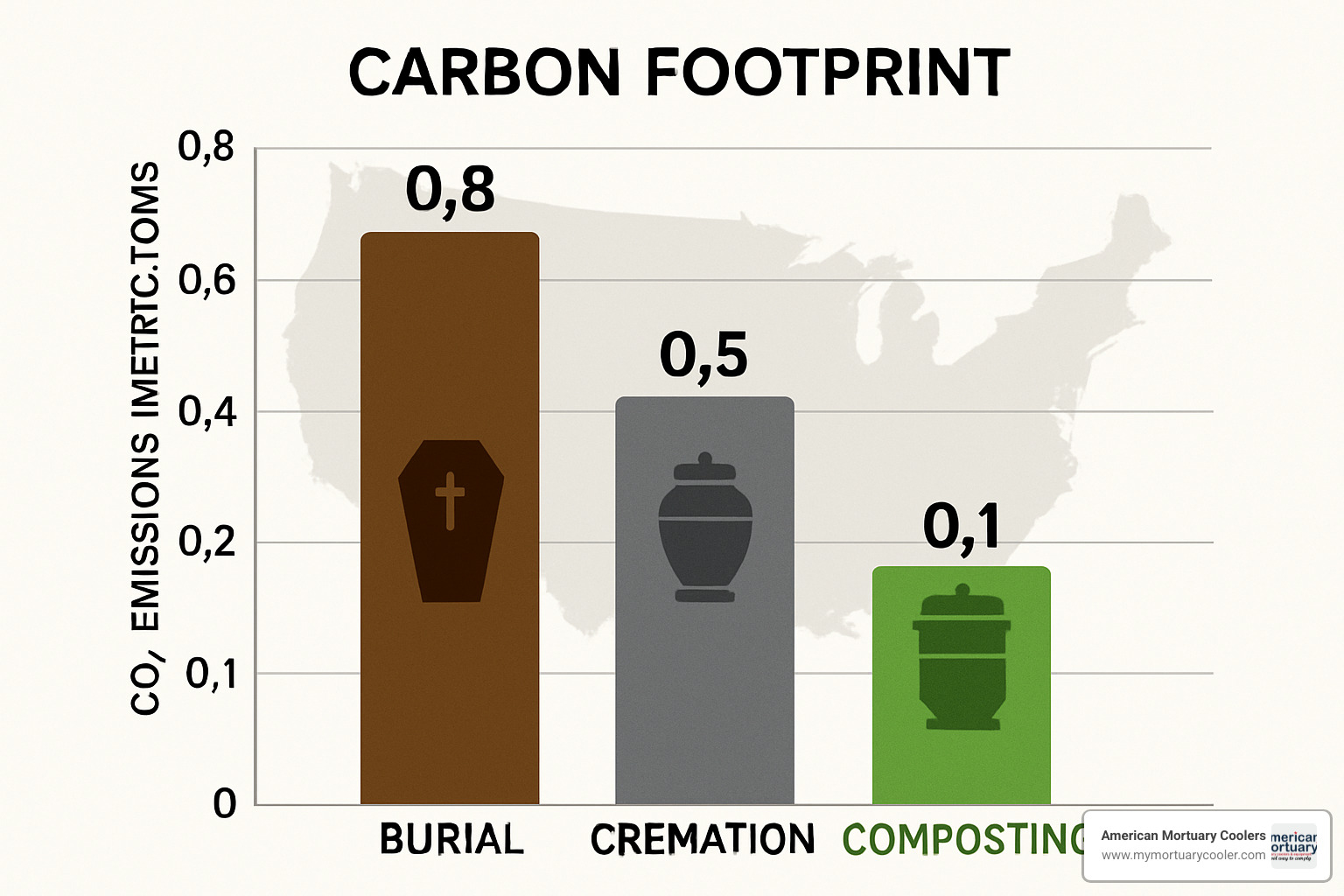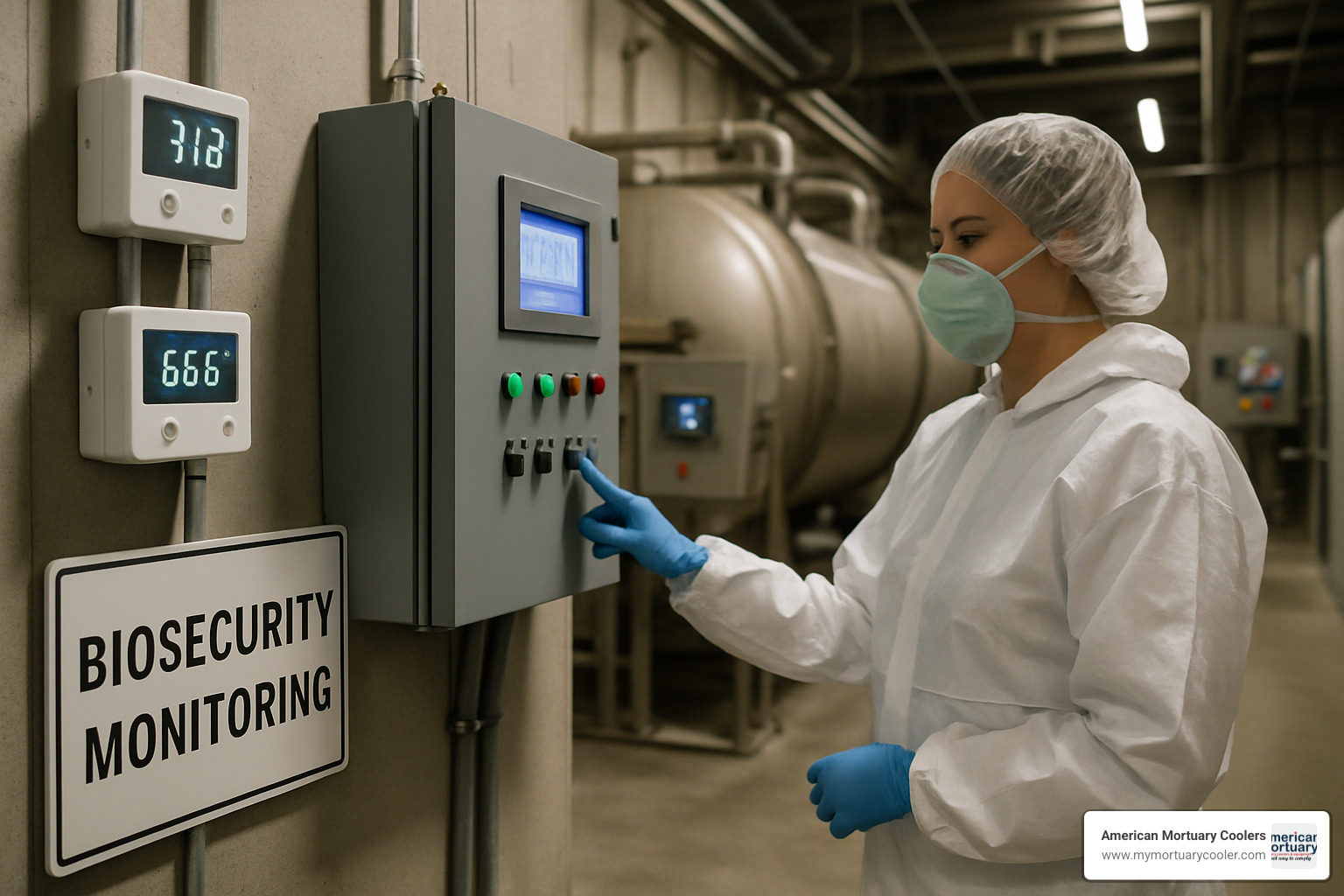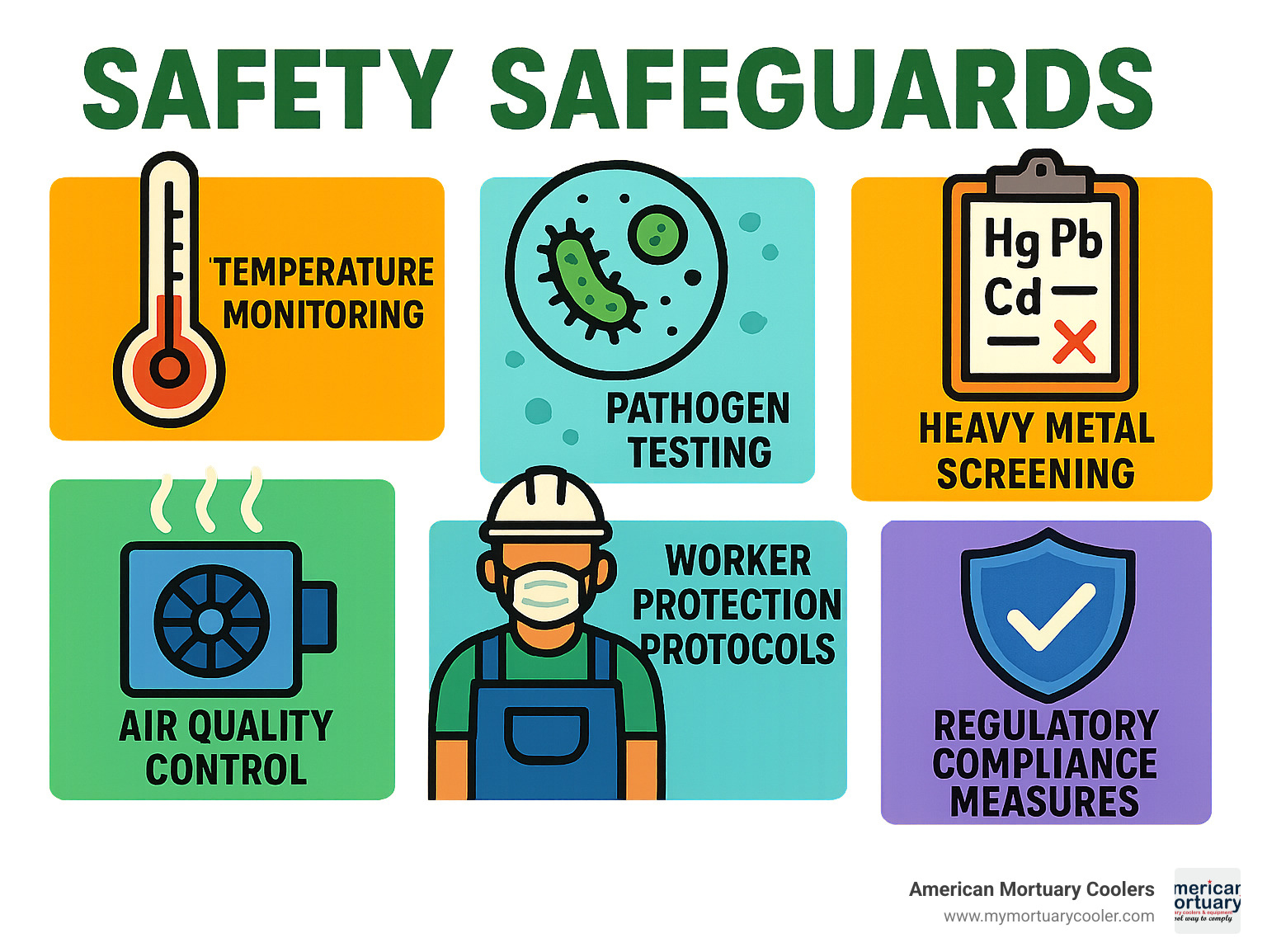Why Composting Your Body is Revolutionizing End-of-Life Care
Compost your body is a new way to turn human remains into nutrient-rich soil through natural organic reduction. This eco-friendly alternative transforms a person into approximately one cubic yard of fertile earth over 8-12 weeks.
Quick Facts About Human Body Composting:
- Process: Body placed in vessel with wood chips, alfalfa, and straw
- Timeline: 5-7 weeks active composting + 3-5 weeks curing
- Output: ~1 cubic yard (500-1,000 lbs) of soil per person
- Cost: $5,000-$7,000 vs $8,300 median burial cost
- Environmental Impact: Saves 1 metric ton of CO₂, uses 87% less energy than cremation
- Legal Status: Available in 12 U.S. states as of 2024
Architect Katrina Spade developed human composting in 2011 after realizing traditional death care was harming the environment. Her work led to Washington becoming the first state to legalize the process in 2019.
The science mirrors what happens on a forest floor. Microbes naturally present in our bodies break down organic matter when given the right mix of carbon, nitrogen, oxygen, and moisture. The controlled environment maintains temperatures above 131°F for at least three days, ensuring all pathogens are eliminated.
Why people choose to compost their bodies:
- Leave a living legacy through soil that nourishes new life
- Reduce environmental impact compared to burial or cremation
- Create memorial gardens or donate soil to conservation projects
- Align end-of-life care with personal values about sustainability
As Mortuary Cooler with over a decade of experience in mortuary equipment and green disposition technologies, I've watched the compost your body movement transform how funeral homes serve families seeking eco-friendly options.

Compost your body terms explained:
What Is Human Composting? Definitions, Origins & Current Science
When you compost your body, you're choosing natural organic reduction or terramation—controlled decomposition that transforms human remains into nutrient-rich soil over several weeks.
The process uses thermophilic microbes that love heat and are already living on our bodies. When they get the right mix of carbon (wood chips and straw), nitrogen (body tissues and alfalfa), oxygen, and moisture, they break down complex proteins and tissues into compounds plants can use.

Architect Katrina Spade founded Recompose after studying how farmers compost livestock and realizing the same principles could work for human remains with proper dignity and safety measures. Scientific research on composting processes has proven this approach creates completely safe, pathogen-free soil.
Unlike cremation's intense heat or traditional burial's slow decay, human composting gently transforms the entire body into soil that can nourish new life.
A Short History of Returning to Earth
Indigenous practices worldwide have honored the natural cycle of returning bodies to earth for thousands of years. The modern green burial movement gained momentum in the late 1900s as people questioned the environmental impact of conventional death care.
Traditional burial consumes millions of acres annually and pumps over 800,000 gallons of toxic embalming chemicals into the ground each year in the U.S. Cremation releases about as much carbon dioxide as driving 600 miles, plus mercury from dental fillings.
Washington became the first state to legalize human composting in 2019. Colorado, Oregon, Vermont, California, New York, Nevada, Maine, Minnesota, Delaware, Maryland, and Arizona have followed suit, showing growing public demand for sustainable death care options.
"Compost Your Body" in Popular Media
The phrase "compost your body" has become the simple way most people describe natural organic reduction. Public perception has shifted dramatically from "that's weird" to "that makes sense." Eco-trend data shows growing interest in sustainable death care, especially among younger generations who prioritize environmental impact in all life choices.
How to Compost Your Body: Step-By-Step Process
The journey to compost your body follows a scientifically-designed process that transforms human remains into life-giving soil over 8-12 weeks. The process happens inside stainless steel vessels that maintain the perfect environment for beneficial microbes, combining wood chips, alfalfa, and straw with calibrated moisture and oxygen flow.

"Compost Your Body" Preparation Phase
Your loved one receives gentle care with body washing using biodegradable soaps. The body is wrapped in a biodegradable shroud made from natural fibers like cotton or linen that will decompose naturally.
Removal of implants is necessary—pacemakers, artificial joints, and metal dental work must come out before composting begins. Licensed funeral directors help coordinate transport logistics, including permits and proper transportation to approved facilities.
"Compost Your Body" Active Reduction Phase
The heart of human composting happens during 30-40 days when microbes begin their work. Vessel rotation introduces fresh oxygen and ensures even decomposition. The vessel maintains 55°C or higher for pathogen kill—eliminating harmful bacteria while preserving beneficial microbes.
Bone refinement requires special attention since bones don't break down as quickly. Remaining bone fragments are carefully removed, pulverized, and mixed back into the compost. The curing phase lasts 3-5 weeks where the composted material rests in aerated bins as the microbial community stabilizes.
Curing, Screening & Soil Return
Lab tests for E.coli and Salmonella ensure the soil meets strict safety standards. Heavy metal screening confirms the soil is safe for environmental use. Each person yields approximately one cubic yard of finished soil, weighing 500-1,000 pounds. The soil texture is rich and earthy, with balanced pH that most plants love.
Environmental, Cultural & Personal Benefits
When you compost your body, you create environmental benefits that extend far beyond traditional burial and cremation. Every person who chooses human composting prevents one full metric ton of carbon dioxide from entering our atmosphere—equivalent to taking a car off the road for 2,500 miles.

Human composting uses 87% less energy than cremation, which must reach 1,400-1,800°F using fossil fuels. Traditional burial consumes millions of trees annually for caskets and requires ongoing energy for cemetery maintenance.
The soil created actively helps heal the planet by sequestering carbon and improving environmental health wherever it's applied. Research shows adding organic matter to soil increases water retention capacity—1% more organic matter helps soil hold an additional 20,000 gallons of water per acre.
Climate & Soil Health Advantages
Traditional burial practices pump over 800,000 gallons of toxic embalming chemicals into American soil each year. These chemicals leach into groundwater and contaminate surrounding soil for years. Human composting eliminates this chemical burden entirely.
Many families create memorial forests using their loved one's soil. These living monuments grow into environmental assets—purifying air, providing wildlife habitat, and combating deforestation while honoring memory.
Personal, Spiritual & Cultural Motivations
The decision to compost your body often reflects a desire to leave an eco-legacy that nourishes new life. Unlike sterile cremation ashes, human compost retains the full spectrum of nutrients that once sustained life.
This process accommodates diverse spiritual beliefs well. Some religious traditions have accepted human composting as fulfilling the biblical promise of "dust to dust." The flexibility allows for deeply personal remembrance practices through memorial gardens or donations to forest restoration projects.
The grief healing process often feels more natural when families can see new life growing from their loved one's remains, providing tangible continuity during the difficult journey of loss.
Costs, Legal Status & Planning Ahead
Human composting costs between $5,000 and $7,000, which is less expensive than the median burial funeral cost of $8,300. Traditional burial can climb to $10,000-$15,000 with cemetery plots, headstones, and maintenance fees. Cremation plus funeral services averages around $7,000.
The human composting price typically covers body care, the change process, basic ceremony options, and return of the finished soil—everything needed for a complete, dignified farewell. More info about composting costs provides detailed pricing breakdowns.
Veterans should know that VA burial benefits may not apply to human composting since it's a newer disposition method. However, life insurance benefits can often cover costs while still honoring military service through personalized memorial ceremonies.
Where It's Legal & How to Advocate
As of 2024, you can compost your body in twelve states: Arizona, California, Colorado, Delaware, Maine, Maryland, Minnesota, Nevada, New York, Oregon, Vermont, and Washington. Several other states have pending legislation.
Washington led the way in 2019, and other states have followed as lawmakers recognize environmental benefits and growing public demand. Scientific research on legal landscape shows this progression continues.
If you live where human composting isn't yet legal, you can support legalization by contacting state representatives, participating in public hearings, and sharing personal stories about why human composting matters.
Making Arrangements Today
For immediate needs, contact a licensed facility in a legal state. Major providers like Recompose offer 24/7 support and coordinate with local funeral homes for body preparation and transportation.
Pre-need planning offers locked-in pricing, reduced family stress, and arrangement flexibility. Many facilities offer pre-planning programs allowing advance arrangements and payments.
Paperwork typically includes death certificates, transportation permits for out-of-state services, and authorization forms. Facilities provide guidance through requirements and recommend experienced funeral directors familiar with human composting logistics.
Concerns, Safety Protocols & Ethical Questions
Human composting facilities operate under strict safety protocols and regulatory oversight. Strict exclusion criteria protect workers and the environment—people with certain infectious diseases, radioactive implants, or recent chemotherapy may not qualify.

Temperature control eliminates pathogens. Composting vessels must maintain temperatures above 131°F for at least 72 consecutive hours—exceeding standards for eliminating virtually all known bacteria, viruses, and parasites. Continuous monitoring creates detailed logs proving the process worked correctly.
Most facilities exclude individuals with suspected prion diseases entirely as a conservative safety measure. Heavy metal screening of finished soil provides another safety layer—every batch gets tested for lead, mercury, and other harmful elements.

Properly managed facilities use negative air pressure systems and specialized filtration to contain any odors. Religious concerns deserve respectful consideration—while some Catholic and Jewish leaders have expressed reservations, others find human composting compatible with teachings about returning to earth.
What Happens to Bones, Teeth & Implants?
Bones and teeth don't completely decompose during composting and need special processing. After initial composting, remaining bone fragments are removed and processed using specialized pulverization equipment, then mixed back into the compost as valuable nutrients.
Metal implants require careful removal. Joint replacements, plates, and dental work get extracted during processing. Many facilities recycle these metals or return them to families for memorial purposes. Pacemakers must be removed before composting begins for safety reasons.
Public Health & Environmental Safeguards
State licensing requirements establish operational standards, monitoring protocols, and enforcement mechanisms. OSHA standards protect facility workers through personal protective equipment requirements, proper ventilation, and comprehensive safety training.
Accredited laboratories analyze soil samples using standardized methods to detect remaining pathogens. This third-party verification ensures finished soil is safe to handle and use. Soil use restrictions vary by state—some prohibit use for food crops while others allow any legal soil amendment use.
Frequently Asked Questions about Compost Your Body
Is the soil safe to use in home gardens?
The soil is absolutely safe for home garden use when properly processed and tested. Every batch undergoes rigorous laboratory testing for dangerous bacteria and heavy metal screening. The high-temperature composting process eliminates virtually all harmful pathogens, creating soil cleaner than many commercial compost products.
State regulations vary on usage—most allow soil for landscaping and ornamental plants without restrictions. Some jurisdictions are more cautious about food crop production, though this reflects regulatory lag rather than safety concerns.
The soil has balanced pH between 6.5 and 7, with excellent nutrient profile including nitrogen, phosphorus, potassium, and sulfur. Families consistently report their memorial gardens thrive with this soil.
How long does the entire process really take?
Plan on 8 to 12 weeks total from vessel entry until you receive finished soil. The first 5-7 weeks involve active composting with major change occurring while maintaining crucial high temperatures for pathogen elimination.
The curing phase follows—another 3-5 weeks where compost rests in aerated bins. Microbial activity continues at lower temperatures, stabilizing everything and developing final soil texture and nutrients. Laboratory testing and administrative work may add a few extra days.
Can families keep some soil and donate the rest?
You get about one cubic yard of soil (500-1,000 pounds)—plenty for both personal memorial use and donation. Most families split the soil between keeping some and donating the rest to conservation projects, forest restoration, or community gardens.
The soil division process is completely flexible. Facilities typically provide containers and help coordinate transportation for both personal wishes and charitable intentions.
Conclusion
The decision to compost your body represents becoming part of nature's endless cycle of renewal. When you choose natural organic reduction, you literally transform into soil that will feed trees, flowers, and wildlife for decades—creating a living legacy.
Human composting offers meaningful benefits: saving one metric ton of CO₂ per person, using 87% less energy than cremation, and costing $5,000 to $7,000 while delivering nutrient-rich soil that actively improves the environment.
Legal acceptance is growing steadily from Washington State in 2019 to twelve states by 2024, with more legislation pending. This momentum reflects what we see at American Mortuary Coolers—funeral homes from Tennessee to California preparing for families wanting sustainable options.
Our climate-controlled storage solutions help funeral homes maintain exact environmental conditions needed for safe, dignified human composting operations. Success depends on getting details right—from temperature monitoring to proper handling protocols.
Planning ahead makes everything easier. Understanding the process and legal requirements removes stress during difficult times. Composting facilities emphasize how much smoother things go when families make arrangements in advance.
What strikes me most about human composting is how it changes our relationship with death itself. Instead of seeing death as ending, compost your body transforms it into beginning. The soil doesn't just sit in a cemetery—it actively nourishes new life, supports wildlife habitats, and helps heal damaged ecosystems.
Families often find unexpected comfort knowing their loved one became fertile earth. Visiting memorial gardens and seeing flowers and trees thriving makes death feel less like loss and more like change.
The movement toward regenerative death care reflects broader changes in how we think about planetary impact. Choosing to compost your body means your final act becomes environmental stewardship—aligning values with legacy.
For more information about supporting green disposition services, explore our resources on green body disposal and find how American Mortuary Coolers can help you serve families choosing regenerative farewell options.
















